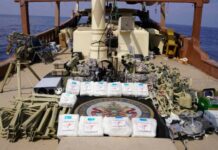US forces in the Red Sea region conducted a fourth strike against Houthi militia targets on 18 January 2024.
US Central Command (CENTCOM) said it “conducted strikes on two Houthi anti-ship missiles that were aimed into the Southern Red Sea and were prepared to launch.
“US forces identified the missiles in Houthi-controlled areas of Yemen at approximately 3:40 pm (Sanaa time) and determined they were an imminent threat to merchant vessels and US Navy ships in the region,” CENTCOM stated in an 18 January press release.
After the Houthi militants defied a joint statement from the United States and 12 other countries issued on 3 January 2024, which warned them against further attacks on international shipping in the Red Sea region, the US military conducted its first strikes on 12 January in conjunction with UK forces. More than 60 targets at 16 Houthi militant locations were struck by US naval aviation and Tomahawk land attack cruise missiles fired from US Navy vessels as well as four Royal Air Force (RAF) Typhoon fighters operating out of RAF Akrotiri on Cyprus.
CENTCOM followed this up with an attack on a Houthi radar site in western Yemen on 13 January, firing Tomahawk missiles from the Arleigh Burke-class destroyer USS Carney.
CENTCOM forces subsequently conducted strikes on 17 January against “14 Iran-backed Houthi missiles that were loaded to be fired in Houthi-controlled areas in Yemen”, the command reported.
Given that US and allied military action has failed to deter the Houthis from using anti-ship ballistic missiles, anti-ship cruise missiles and bomb-laden unmanned aerial vehicles to attack international shipping and US naval forces in the Red Sea region, the series of US attacks against the Houthis now seems focused on degrading their capability to wage such operations.
“These strikes, along with other actions we have taken, will degrade the Houthis’ capabilities to continue their reckless attacks on international and commercial shipping in the Red Sea, the Bab-el-Mandeb Strait, and the Gulf of Aden,” CENTCOM stated on 17 January.
However, it seems unlikely that the US strikes can completely negate the threat from the Houthis, who, materielly backed by Iran, have already demonstrated their resilience in the face of military action from a Saudi-led coalition since 2015.
Thus, international shipping companies continue to be forced to divert their vessels around the Horn of Africa, instead of transiting the Red Sea and Suez Canal, at significant cost in terms of time and expense. Almost 15% of global seaborne trade has usually passed through the Red Sea route.
Facilitating passage of international merchant shipping through the Red Sea while the Houthi threat continues would require a significant naval operation by the US and its allies, effectively instigating a convoy system to provide a comprehensive air defence umbrella against the Houthi attacks.
Hostile Houthi action in response to the Israel Defense Forces’ campaign against Hamas militants in Gaza began on 19 October 2023 following Hamas’ terrorist attack on southern Israel on 7 October 2023. The Houthis started targeting US naval and international shipping from 15 November.













